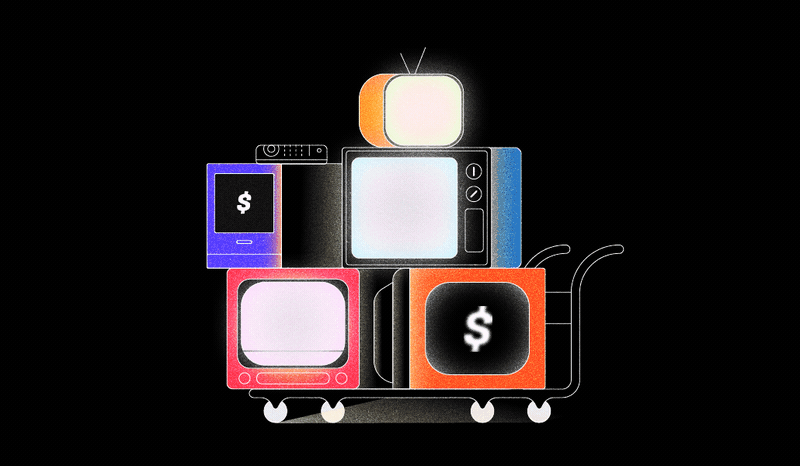Media Buying Briefing: Why buyers think VideoAmp has a jump in the alternative TV measurement race

This Media Buying Briefing covers the latest in agency news and media buying for Digiday+ members and is distributed over email every Monday at 10 a.m. ET. More from the series →
The 2023-24 upfront marketplace isn’t likely to get started anytime soon, agreed media buyers last week.
That’s largely because marketers are holding off on approving budgets until there’s more clarity on a few factors: economic conditions in the second half of 2023, as well as on the writers’ strike that will slowly start to strangle the flow of original scripted content if it’s not soon settled.
Adding to the confusion is the reality that this year, both sellers and buyers plan to increase the amount of inventory bought using alternative measurement sources other than Nielsen, which it’s safe to say has had a bumpy few years. Between VideoAmp, iSpot and Comscore (the latter which national buyers paid less attention to since it seems to be focused more on local measurement), Nielsen will not be the only currency used to plan, buy and post by media agencies.
And although non-Nielsen currencies will still represent only a fraction of the marketplace, as Digiday’s Tim Peterson recently pointed out, the fact is, media agencies believe this marks the beginning of a better way.
“I think there’s going to be definitely some meaningful pockets of change this year,” said the head of measurement and data at a major holding company network who declined to speak on the record.
Seemingly leading the way among the companies vying for a piece of the video measurement pie is VideoAmp, which in recent months has secured partnerships with every major video seller in the linear and streaming spaces, including Warner Bros. Discovery, Paramount, TelevisaUnivision, Allen Media Group, NBCU and FOX — its executives like to point out that it’s the most of any new currency that’s emerged. Although Disney hasn’t signed up to test VideoAmp’s currency, it is using it for measurement, and the company’s president Michael Parkes expects to one day cross the currency threshold with the media conglomerate.
“The broader momentum around new currency as an alternative … is accelerating in general,” said Parkes.
The company last week announced a deal it struck with TransUnion to essentially layer the latter’s consumer purchase data onto VideoAmp’s tracking of viewership, leading to optimizing campaigns based on outcomes.
VideoAmp has made strides in securing the buy-side’s buy-in, having inked formal agreements with Horizon Media, Omnicom Media Group, Dentsu and Empower to use its currency. Parkes even points to brand advertisers including Wayfair and Luxxotica that are employing VideoAmp.
“We’re engaged with all of the major holdcos, and even advertisers directly over the past four months,” said Parkes. “They all have their own secret sauce of leveraging our capabilities in partnership with their own, whether that’s audience data or capabilities for optimization.”
Dave Campanelli, Horizon Media’s chief investment officer, pointed to two benefits of working with alternatives like VideoAmp. For one, counting impressions off a 30-40 million user base is much more effective than off smaller panels that reach only thousands of viewers. “That should provide a much more stable and accurate data set for basic impression counts,” said Campanelli.
For another, Campanelli said VideoAmp’s measurement tools offer, for now, the best non-Nielsen improvement for planning, buying and posting — all of which currently work off Nielsen data (as they have for decades). “For the time being, we’re opening with that disconnect — we’re gonna work through it in order to get to a better place,” he added. “While they [VideoAmp] don’t have a perfect agency planning solution, they do have tools that are close to that. This isn’t going to replace everything we’re doing from a planning perspective right now, but let’s engage and partner so they can understand what we need as an agency.”
The on-background exec agreed VideoAmp brings the broadest access to the sellers agencies need to negotiate with. “They have done a pretty good job of integrating with a bunch of different, you know, partners, publishers,” said the exec, whose holding company plans to formalize a partnership with VideoAmp at some point in the future.
Once the dust settles on upfront dealmaking — and that could be later in the summer — buyers and sellers will take stock of what worked, and didn’t work. Then the industry might have an even clearer picture of which rival to Nielsen stands a chance to really compete for the billions spent on measurement and currency.
Color by numbers
WARC Media’s platform insights report reveals that YouTube has become the biggest TV streaming platform after overtaking Netflix in the U.S last year. It should come as no surprise, given that people watch more than one billion hours of video on the platform every day globally. — Antoinette Siu
More findings:
- YouTube’s global ad revenue is expected to rise 4% in 2023 to reach $30.4 billion – double the rate of growth from last year. More growth is ahead: WARC forecasts a 10.3% ad revenue growth to $33.5 billion in 2024.
- Retail brands are expected to spend some $4.1 billion on YouTube this year, up 4.6% from 2022. It accounted for 22.9% of OTT viewing in March 2023.
- However, YouTube Shorts’ 50 billion daily viewers still lags behind the 140 billion daily views generated by Instagram Reels. Additionally, users under 18 spend an average 60% longer on TikTok compared to YouTube content.
- YouTube advertisers have the potential to reach 2.07 billion people – half of all internet users worldwide.
Takeoff & landing
- Identity ad-tech firm Ogury has jumped into the attention metrics space, by partnering with Adelaide and Lumen Research to incorporate attention insights into its Personified Advertising tool.
- Havas Media Group will handle media and strategy for PNC Bank after the advertiser chose Havas sibling shop Arnold Worldwide to handle its marketing and advertising.
- Software platform DoubleVerify rolled out a new toolkit, DV Marketplace Suite, that extends brand-safety, fraud, viewability and contextual controls to SSPs, DSPs, ad exchanges and retail media networks.
Direct quote
“The time must surely be ripe for a challenger business that’s now achieved a significant critical mass to attempt to rip a prestigious media account from a holdco incumbent. Growth by acquisition is one route, but when a business reaches the scale of a Brandtech Group, it needs a huge, headline-grabbing account win to fuel meaningful organic growth and feed the beast.”
— Matthew Lacey, partner at London-based financial consultancy Waypoint Partners, on Brandtech Group’s acquisition of Jellyfish last week.
Speed reading
- Digiday media agency reporter Antoinette Siu looked into how media agencies are addressing, and adapting to, the flood of content that’s seemingly everywhere, and how to guide clients through when to make their own content.
- In a related story, senior news editor Seb Joseph explains why the explosion of short-form content is actually leading advertisers to seek out more long-form content as a means of securing deeper engagement with consumers.
- And just to round out Digiday’s coverage of video, gaming and esports reporter Alexander Lee looks at how smaller gamer creators are benefiting from generating short-form video on platforms like TikTok and YouTube Shorts — with insights provided by Gamesight.
More in Media Buying

Omnicom confirms the pending exit of influential Annalect chief Slavi Samardzija
The CEO and architect of Omni departs, hinting at pending changes as Omnicon continues $13.5 billion IPG takeover bid.

WPP has its next CEO – but what do clients make of the heir apparent?
The ad industry’s hot take industrial complex went into overdrive upon yesterday’s WPP coronation. Clients are keeping their counsel, however.

Who is Cindy Rose, WPP’s insider-outsider pick for its next CEO?
The British holding company has named its next CEO — a Microsoft executive and board member of six years.







